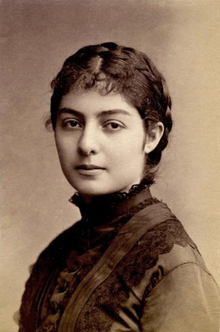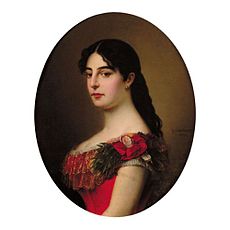- Natalie of Serbia
-
Natalie Keşco
Наталија Обреновић
Queen Natalie of Serbia Queen consort of Serbia
Princess consort of SerbiaTenure 17 October 1875 – 6 March 1889 Spouse Milan I of Serbia Issue Alexander I of Serbia
Prince SergeiFull name Natalija Keşco House House of Obrenović Father Colonel Petre Keşco Mother Princess Pulcheria Sturdza Born 15 May 1859
Florence, ItalyDied 8 May 1941 (aged 81)
St. Daniel, FranceBurial Cemetery of Lardy, Seine et Oise Religion Eastern Orthodox; later Roman Catholic Natalie Keşco (Serbian: Natalija Obrenović/Наталија Обреновић; 15 May 1859 - 8 May 1941) was Princess consort of the Principality of Serbia from 1875 to 1882 and the Queen consort of the Kingdom of Serbia from 23 March 1882 to 6 March 1889 as the wife of King Milan Obrenović IV.
Contents
Early life and royal marriage
She was born in 1859 in Florence as the first child of the Russian colonel Piotrj Ivanovich Keşco (born Petre Keşco, son of a Marshal of Nobility of Bessarabia) (1830-1865), and Princess Pulcheria Sturdza of Moldavia (1831-1874). During her childhood, a fortune teller predicted that some day she would wear a crown and that she would lose it - a prediction that would come true.[citation needed]
She had two sisters and one brother:
- Maria (Mary) (1861-1935), who married on 13 April 1886 Prince Grigore Ghica-Brigadier (1847-1913).
- Ecaterina (Catherine), who married on 5 February 1883 their relative Prince Eugen Ghica-Comăneşti (1840-1912).
- Ioniţă (John), only brother; he was the fourth and last child.
She married Prince Milan Obrenović IV of Serbia on 17 October 1875 and had two sons with him, the future king Alexander, born 1876, whose godfather was Tsar Alexander II of Russia, and his younger brother Sergei (Sergije), who died just a few days after his birth in 1878.
When Prince Milan proclaimed the Kingdom of Serbia in 1882 after securing international recognition, Princess Natalie assumed the title and rank of Queen of Serbia.
Royal conflict and divorce 1887/88
The relationship of the Royal couple reached a critical level in 1887, following many affairs of the king with other women, but even political differences between king and queen. The king pursued a pro-Austrian foreign policy which the Russian-born and slavophile queen would not tolerate.
These conflict developed into a public scandal when the queen - accompanied by her child, the eleven-year-old crown prince Alexander - left Serbia and settled in the Russian Crimea in May 1887. Slavophile public in Russia honoured the Serbian queen demonstratively. Rumours spread about a royal divorce in the near future, and there was public talk about the king's abdication in favour of his son. These rumours proved to be premature - the divorce occurred one year later, the abdication followed in 1889. In July 1887, the queen and her son returned to Belgrade, in August the queen left her country again for Austria-Hungary. In October, king and queen met in Budapest for a formal reconciliation, and with the king's approval the queen and the crown prince left for another foreign travel to Italy until November.
In 1888, Queen Natalie and her son left for another long foreign stay in Wiesbaden - obviously without intention to return to Belgrade. The public private scandal turned into politics when the king used the German police in July 1888 to bring the young crown prince back to his kingdom.
Soon afterwards King Milan opened the ecclesiastical procedures of divorce. Even the development of these procedures put a shadow on the royal reputation. The Holy Synod of the orthodox church of Serbia declared itself incompetent in the royal divorce. When the consistorium of Belgrade took over the case the queen rejected the king's wish for divorce and advocated the several attempts to reconcile the couple according to ecclesiastical law. When the king managed to get his divorce by a single decision of the Metropolite of the Serbian church, the queen rejected that decision in public and declared to consider herself still the wife of the king.
An immediate political consequence of these dynastic conflicts was the new right of succession to the throne proclaimed during the parliamentary sessions regarding the new constitution of Serbia. The new constitution declared Crown Prince Alexander and his future children (that never were born) to be single legal heirs of the Serbian crown. Possible children of a second marriage of King Milan should be excluded from succession even in the case that Prince Alexander's line should become extinct. A clear votum of mistrust for the king in the handling of his family affairs that foreshadowed his following abdication in March 1889.
Conflicts with the Regency and private reconciliation
On 6 March 1889, as consequence of the surprising abdication of her (former) husband, Natalie's son Alexander I became king of Serbia. Until 1893, when Alexander assumed government himself, he was put under a regency council led by former prime minister Jovan Ristic. The former king Milan secured the educational rights for his son for himself and ordered the regency council not to allow the queen mother a permanent stay in Serbia during the minority of King Alexander. Short meetings between mother and son in foreign countries should be possible with permission of the regency.
Queen Natalie did not accept these restricted conditions. In August 1889, she announced publicly to visit her son in the royal palace in Belgrade. Even when Ex-king Milan modified his restrictions to her favor she was not prepared to be restricted at all and insisted on her maternal right to visit her son whenever it should please her, regardless of the government's consent or refusal. When the queen mother indeed arrived in Belgrade on 29 August 1889, she was enthusiastically welcomed by the population.
But the regency denied her royal style (she should be announced just as Mme Keshko) and - after she insisted to be still the ex-kings wife and rightful queen of Serbia - any meeting with her son. In October 1889 the ex-king and the regents allowed meetings between mother and son every 14 days - but strictly outside the royal palace.
In July 1890, the Synod of the Serbian Orthodox church declared the divorce between Milan and Natalie to be legal.
In April 1891, ex-king Milan - after several interferences in government affairs - announced his intention to leave Serbia until his son should be old enough to take over the rule. The parliament instructed the government to ask queen mother Natalie to act accordingly. When the queen refused to leave the country, the police tried to expel her by force on 18 May 1891. The queen opened the window and cried for help to the public, and indeed a crowd of civilians fought the police and the military, freed the queen and triumphantly took her back into her palace. But on the next day, the force of the whole military garrison of Belgrade was used to secure the departure of the queen into exile.
In January 1893, the exiled royals Milan and Natalija reconciled and asked the Serbian government to revoke their divorce. The Metropolite and the synod declared the divorce act of 1888 illegal and the royal marriage still in force in March 1893.
Shortly afterwards their son King Alexander declared himself mature and deposed the regency council in April 1893.
Return and second exile
After ex-king Milan had returned to Serbia in January 1894 and took the position as deputy of his son and commander-in-chief of the army, King Alexander ordered the complete rehabilitation of his parents and the restoration of their royal prerogatives in April 1894 - despite the protests of the radical opposition. Natalie, who lived mainly in France, returned to Belgrade not before May 1895 but kept her habit of frequent foreign travels.
When King Alexander affianced himself with Draga Mašin, a former court lady of Queen Natalie, in 1900, his parents rejected the future queen as improper. Ex-king Milan resigned as army commander and left Serbia for the rest of his life; he died in Vienna a year later, in 1901. Even the relationship between Natalie and Alexander was broken up. Because the queen mother was a strong opponent of her son's marriage to Draga, Natalie was banished from Serbia by her son.
King Alexander and his wife Draga were killed in 1903 during a military coup. This left Natalie the sole member of the Obrenović dynasty. She donated the inheritance to the University of Belgrade and various churches and monasteries around Serbia. The same year, Queen Natalie became member of the Roman Catholic Church and a nun.
Queen Natalie spent the remaining years of her life in exile in France. She died in 1941 in St. Daniel, France, other sources indicate Paris. Her unpublished memoirs were kept in the Vatican, but have been published in Belgrade in 1999.
Ancestry
Ancestors of Natalie of Serbia 16. Petre Keşco 8. Ioniţă Keşco 17. Bălaşa Vârnav 4. Ioniţă Keşco, marshal of the bessarabian nobility 18. Manolache Costache, governor of Moldavia 9. Tarsiţa Costache 19. Maria Pallady 2. Colonel Petre Keşco 20. Boyar Costache Balş 10. Boyar Gheorghe Balş, great treasurer of Moldavia 21. Aniţa Caţargi 5. Natalija Balş 22. Prince Grigore Sturdza 11. Princess Ruxandra Sturdza 23. Princess Mărioara Callimachi 1. Natalija, Princess and Queen consort of Serbia 24. Prince Alexandru Sturdza 12. Prince Ioniţă Sturdza Vodă 25. Maria Bogdan 6. Prince Nicolae Sturdza 26. Prince Nicolae Rosetti-Roznovanu 13. Princess Ecaterina Rosetti-Roznovanu 27. Smaranda Hrisoscoleu 3. Princess Pulcheria Sturdza 28. Prince Costache Ghica-Comăneşti 14. Prince Dimitrie Ghica-Comăneşti 29. Maria Iordache 7. Princess Maria Ghica-Comăneşti 30. Răducanu Rosetti 15. Zoe Rosetti-Răducanu 31. Ileana Balş Succession
Royal titles Preceded by
Júlia Hunyady von KéthelyPrincess consort of Serbia
17 October 1875 – 6 March 1882Succeeded by
Herself as Queen consortPreceded by
Herself as Princess consortQueen consort of Serbia
6 March 1882 – 6 March 1889Succeeded by
Draga MašinCategories:- 1859 births
- 1941 deaths
- People from Florence
- House of Obrenović
- Yugoslav queens consort
- Female regents
- Serbian Roman Catholics
- Converts to Roman Catholicism from Eastern Orthodoxy
Wikimedia Foundation. 2010.

